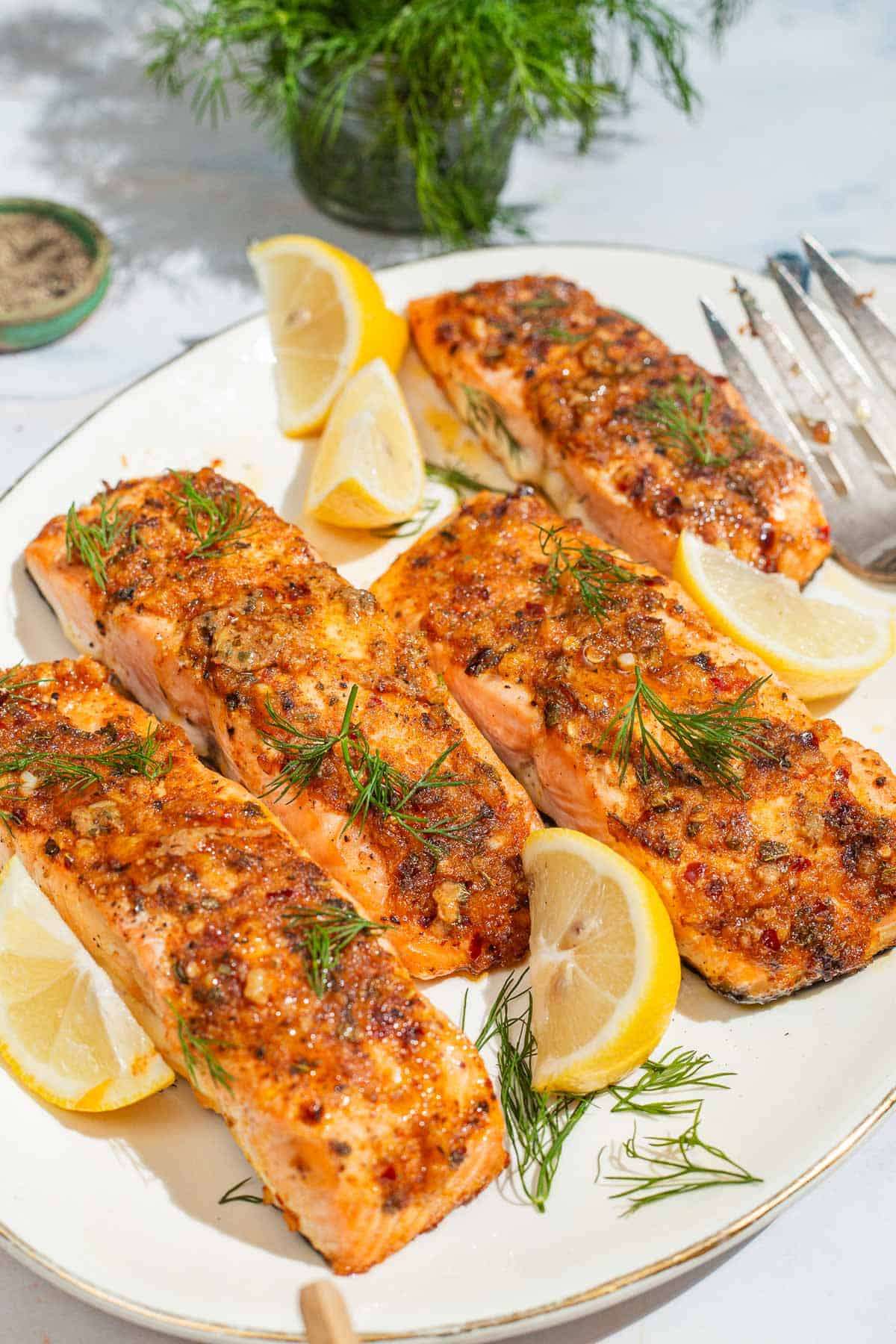
5.0 from 30 votes
Dijon Salmon
This Dijon Salmon recipe comes from my second cookbook, where I shared my favorite simple dishes that bring more joy without the fuss. This extra simple recipe does just that: a fail proof yet absolutely incredible dish you can make in minutes and the whole family will love. Serve with something fresh and green and couscous or your favorite grain.
Prep Time
10 mins
Cook Time
10 mins
Resting Time
10 mins
Total Time
30 mins
Servings: 4
Calories: 3443 kcal
Course:
Main Course
Cuisine:
Mediterranean
Ingredients
For the Garlic Dijon Sauce
- 1/4 cup extra virgin olive oil
- 1 small lemon, zested and juiced
- 1 1/2 teaspoons Dijon mustard
- 3 large garlic cloves, minced
- 1 teaspoon dried oregano
- 1/2 teaspoon ground coriander
- 1/2 teaspoon sweet paprika
- 1/2 teaspoon red pepper flakes, optional
For the Salmon
- extra virgin olive oil
- 4 (5-ounce) salmon fillets (skin-on center-cut preferred)
- kosher salt
- ground black pepper
- 2 tablespoons chopped fresh dill
- 1 small lemon, cut into wedges, for serving
Instructions
- Get ready. Position one oven rack in the center and one rack about 6 inches from the broiler. Preheat to 375°F.
- Prepare the Garlic and Dijon Sauce. In a small bowl, whisk together the olive oil, lemon zest, lemon juice, Dijon mustard, garlic, oregano, coriander, paprika, and red pepper flakes (if using).
- Prepare the salmon: Line a large sheet pan with foil, leaving enough excess foil over one long side to fold over the salmon without touching it. Place a piece of parchment on top of the foil and brush with olive oil.
- Season the salmon. Pat the salmon dry and place the fillets on top of the parchment with the skin side down. Season with a good pinch of salt and black pepper (about 1/2 teaspoon each). Pour the prepared sauce over the salmon.
- Bake the salmon. Fold the excess foil over the salmon, tenting it high enough so it doesn’t touch the fish. Crimp or fold the foil sides to completely enclose the fish. Bake for 15 to 20 minutes, or until the salmon is almost cooked through at the thickest part.
- Broil the salmon. Carefully remove the sheet pan from the oven and open the foil to uncover the top of the salmon. Place the salmon on the top rack and turn the broiler to high. Broil for 1 to 3 minutes, or just until the top of the salmon browns lightly. Watch closely to avoid overcooking and burning the garlic. Remove the salmon from the oven (see note).
- Serve. Sprinkle the salmon with dill and serve with lemon wedges on the side.
Cup of Yum
Notes
- to browse quality Mediterranean ingredients including the
- olive oil
- and
- spices
- used in this recipe.
- : Close the tent of foil and let it rest for just a couple of minutes. Don’t leave it too long because even after pulling it from the oven salmon can easily go from undercooked to dry.
- When your fish is ready, it should flake at the touch of a fork. Poke the salmon with your fork at the thickest part and gently pull a piece of the flesh away; your fork should not meet any resistance. If you like, you can use an instant-read thermometer to check for doneness. The USDA recommends an internal temperature of 145°F, which should be measured at the thickest part of the fish fillet, but personally I think the sweet spot for salmon is somewhere around 135°F.
- Shop this recipe: Visit our shop to browse quality Mediterranean ingredients including the olive oil and spices used in this recipe.
- Once you remove the salmon from the oven, if it appears underdone where some parts are still translucent: Close the tent of foil and let it rest for just a couple of minutes. Don’t leave it too long because even after pulling it from the oven salmon can easily go from undercooked to dry.
- When Is Salmon Ready? When your fish is ready, it should flake at the touch of a fork. Poke the salmon with your fork at the thickest part and gently pull a piece of the flesh away; your fork should not meet any resistance. If you like, you can use an instant-read thermometer to check for doneness. The USDA recommends an internal temperature of 145°F, which should be measured at the thickest part of the fish fillet, but personally I think the sweet spot for salmon is somewhere around 135°F.
Nutrition Information
Calories
344.3kcal
(17%)
Carbohydrates
6.6g
(2%)
Protein
29.1g
(58%)
Fat
22.9g
(35%)
Saturated Fat
3.3g
(17%)
Polyunsaturated Fat
5.1g
Monounsaturated Fat
12.9g
Cholesterol
78mg
(26%)
Sodium
89.3mg
(4%)
Potassium
802.6mg
(23%)
Fiber
2.1g
(8%)
Sugar
1.5g
(3%)
Vitamin A
291.3IU
(6%)
Vitamin C
29.6mg
(33%)
Calcium
48mg
(5%)
Iron
1.9mg
(11%)
Nutrition Facts
Serving: 4Serving
Amount Per Serving
Calories 3443
% Daily Value*
| Calories | 344.3kcal | 17% |
| Carbohydrates | 6.6g | 2% |
| Protein | 29.1g | 58% |
| Fat | 22.9g | 35% |
| Saturated Fat | 3.3g | 17% |
| Polyunsaturated Fat | 5.1g | 30% |
| Monounsaturated Fat | 12.9g | 65% |
| Cholesterol | 78mg | 26% |
| Sodium | 89.3mg | 4% |
| Potassium | 802.6mg | 17% |
| Fiber | 2.1g | 8% |
| Sugar | 1.5g | 3% |
| Vitamin A | 291.3IU | 6% |
| Vitamin C | 29.6mg | 33% |
| Calcium | 48mg | 5% |
| Iron | 1.9mg | 11% |
* Percent Daily Values are based on a 2,000 calorie diet.